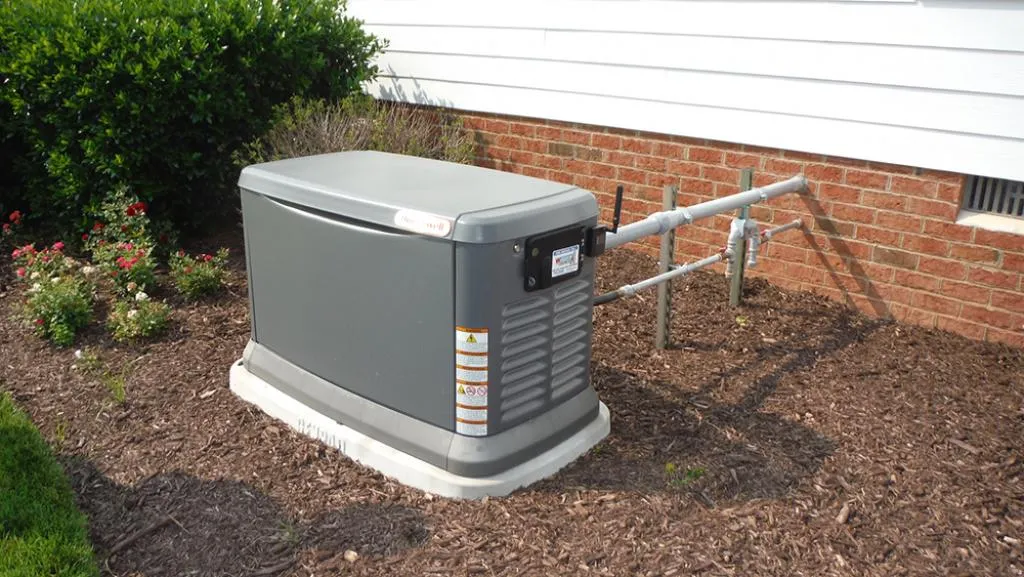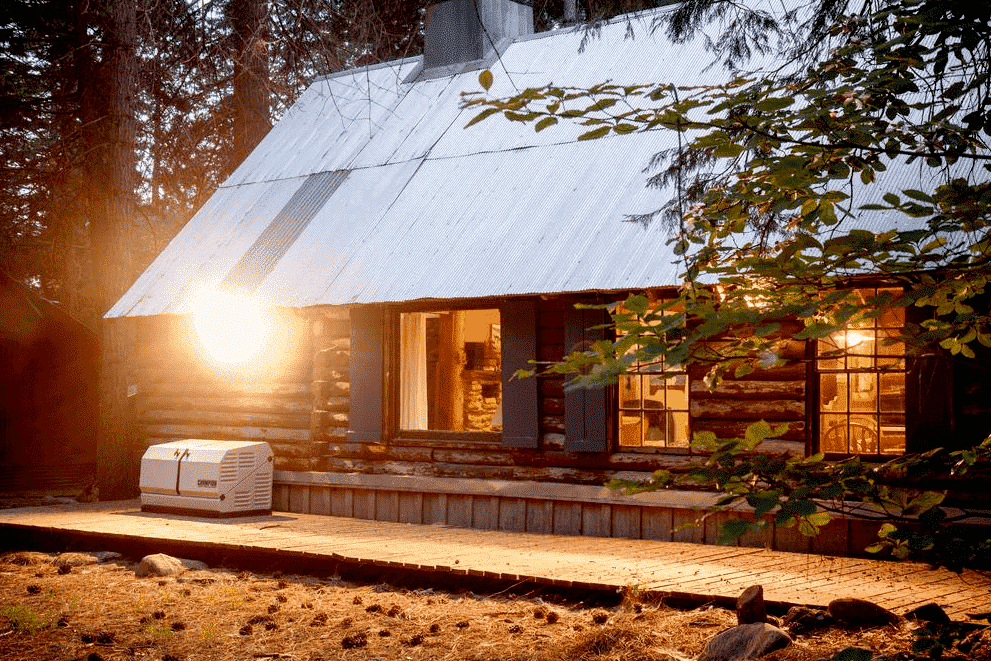A portable generator is essential for providing power to electronic devices, appliances, and lighting in remote settings such as campgrounds or RVs. However, when there's a power outage at home, a portable generator won't have enough power output to supply the entire home; that's why you need a standby generator; especially if the power outages are a frequent occurrence or a major concern for you and your family. The best home standby generator will do you justice.
What’s a Home Standby Generator?
A home standby generator is a power source that is permanently installed outside your home in case of a power outage. It usually looks like an air conditioner powered by your home's existing natural and propane gas. These home generators often operate on two types of switches; manual or automatic transfer switches. An automated transfer switch (ATS) operates independently, without the need for you to manually turn it on.

A standby generator monitors your electricity, patiently waiting for a disruption in your home's main electrical panel and turning it on in the case of a power outage. Within seconds of no lights, your standby home generator kicks in to provide backup power to your home. (As a result, home generators are frequently referred to as backup generators.)
Now that we know what a standby generator is let's check out the best models on the market.
1. Champion Home Standby Generator
- Seamless 24/7 Power – No refueling, no manual operation, no...
- Sub Zero Start – 24V starting system designed to operate down...
- Easy Access – Innovative gullwing enclosure for easy...
- Quiet Power – Low tone muffler and sound dampening liner for...
- ATS50 – 50 amp, 10 circuit, outdoor rated (NEMA 3R) automatic...
During our evaluation of the Champion 100177 Home Standby Generator, we found its operational simplicity quite remarkable. The generator provides immediate response during power failures, ensuring continuous operation of crucial home appliances. In addition, the automatic transfer switch efficiently transitions household power to generator supply without requiring manual intervention is a great addition.
Keep in mind, you can complete the installation process yourself, though professional installation services are highly recommended. While the installation manual provides clear guidance, some people might express difficulty when it comes to understanding transfer switch specifications. However, once installed, the system operates by itself without needing to refuel or manual operation, providing reliable backup during power interruptions.
Pros:
Cons:
2. Champion aXis 22 kW Generator
- Up to 20% more fuel efficient than leading competitors, this...
- With less wiring and lower installation costs thanks to our Power...
- Thanks to advanced sound dampening and a specially designed...
- 24-volt starting system operates in sub-zero or extreme heat...
- Includes 10-year limited warranty with FREE lifetime technical...
The Champion Power Equipment 201222 Home Standby Generator is a power solution that has more efficiency compared to normal generators. The aXis technology can make installation very simple, and the transfer switch is very useful during outages.
The fuel consumption shows high efficiency with 3.6 gallons per hour on propane that need less refueling work. It comes with a 67 dBA noise level and aluminum-zinc coated steel enclosure for weather resistance.
Pros:
Cons:
3. Kohler 20kW Standby Generator
- Automatically restore power in just 10 seconds with the premium...
- Compatible to run on natural gas (18kW) or liquid propane (20kW)...
- Includes RXT 200-amp outdoor-rated, service entrance rated...
- Powered by reliable KOHLER Command PRO engine, designed and...
- PowerBoost technology provides power to start large loads such as...
If you're looking for the best home standby generator to serve you for long during a power outage, count on the Kohler 20kW Standby Generator. This generator is ideal for home use. Its dependability is also great. Besides, after the electricity is off, it takes 10 seconds for this generator to achieve a full-functioning state.
The energy is extremely pure, with less than 5 percent Total Harmonic Distortion, which protects sophisticated electronics like computers. In addition, the design is high-quality, with corrosion-proof housing that can survive any adverse weather. There is also no need to create a concrete pad because this automatic standby generator comes with a polymer foundation for direct installation.
Like the Generac generator models, this Kohler generator has internet monitoring capabilities, and the system will even alert you through a text for maintenance reminders. Conversely, as mentioned, this high-capacity standby generator is ideal for business applications and big houses.
Pros:
Cons:
4) Generac 7042 22Kw Standby Generator
- Reliable Power: True Power Technology delivers best-in-class...
- Automatic Transfer Switch: Automatic transfer switch sold...
- User-Friendly Control: Generac Evolution Controller features LED...
- Durable Enclosure: Tough all-weather aluminum enclosure with 3...
- Battery Requirement: Battery not included. Generac Battery 7042...
Our experience with the Generac 7042 has shown more reliability than normal backup power systems that are used for many different works. Generac 7042 provides high quality power supply, and maintains power during storms.
The LED controller system adds many benefits to daily operation like helping with status checks and maintenance alerts. The aluminum enclosure makes operation very safe in extreme weather conditions. Professional installation is very important during setup time.
Pros:
Cons:
5) Kohler 26RCAL-200SELS Air-Cooled Standby Generator
- 26KW rated LP/ 24KW rated NG
- 999cc Command Pro V-Twin Engine
- 200amp Automatic Transfer Switch and OnCue Plus
During electricity shortages, the Kohler 26RCAL-200SELS generator functions exceptionally well. It effectively maintains the operation of any of our necessary equipment with its 26,000 watts. When there is an unplanned blackout of power, the automatic transfer switch will effortlessly engage within 10 seconds, proving its dependability and quickness.
One notable feature is the dual fuel capacity, which lets you select between liquid propane and natural gas. When deciding which choice is better considering availability, this flexibility becomes particularly helpful. Because the commercial-grade engine is constructed to survive harsh conditions, it gives you peace of mind, which is advantageous if you live in an area with unpredictable weather.
Pros:
Cons:
Home Standby Generators Vs. Portable Generators

- As the name suggests, a standby generator is a permanently installed backup electrical supply while portable generators can be moved. Though it's possible to install portable generators to start automatically in case of a power outage, we discourage it due to the risk of fire and reverse current flow.
- Starting a generator can take a long time and involves a precise succession of processes. As a result, the best standby generators are the more user-friendly solution.
- For commercial reasons, the rapid response of standby generators is critical. For instance, a power outage of just a few seconds may be devastating in hospitals and power plants.
- These generator types have a difference in their capacity. A portable generator is rarely as strong as a standby generator for your house.
- Most home backup generators are directly linked to the building's natural gas supply, ensuring a consistent fuel flow at a lower cost. Conversely, this is rarely achievable with portable generators because most run on diesel or gasoline, with greater operating expenses.
Factors to Consider Before Buying the Best Home Standby Generator
1. Size and power requirements
When deciding on the best home standby generators to supply power to your home, pay attention to the size and power needs of the home. Check the power wattage of essential appliances such as the refrigerator, freezer, and furnace. Then add the wattage of all relevant appliances to determine the total wattage required to run the residence. This power wattage will normally range between 5,000 and 7,500 watts, while it's recommended that you choose a generator that can offer more than the minimum requirement.
Conversely, the size of a generator, in this case, relates to its electrical output rather than its physical size. Whole house generators can range from as low as 7,500 watts for small houses and as high as 50,000 watts for large homes; however, most are between 20,000 and 30,000 watts. The starting watts level on these machines refers to the electrical output when the generator is initially turned on. It is typically 2,000 watts more than the operating watts output, which is the rating for the continuous power output when the generator runs for more than a few minutes.
Therefore, when selecting the best whole house generator for your appliances, always utilize the running watts rating because the starting watts rating is not a valid indication of the generator's capability.
2. Fuel source
When determining the optimum fuel source for the backup generator, there are various alternatives to consider, including liquid propane, diesel, natural gas, and dual-fuel solutions.
- Liquid propane (LP)- This fuel type is the most commonly used for most home standby generators. Propane-powered generators can be connected to the home's primary propane tank or have their private tank. Besides, propane is a cleaner-burning fuel that is more efficient than natural gas.
- Diesel- is a highly efficient fuel source that generates more power per gallon than natural gas and liquid propane. Nonetheless, diesel generators might be hard to obtain. They emit toxic exhaust fumes that may be a concern in a residential area, depending on the closeness of neighbors, the presence of children or pets, and the size of the yard.
- Natural gas (NG) as a fuel type is relatively common, especially for backup power generators. Since these huge machines are semi-permanently installed, some users usually prefer to connect the generator directly to their natural gas line, eliminating the need to refill the generator. Nonetheless, natural gas is the least efficient fuel source available, although when compared to diesel generators, these generators usually make up for the inefficiency with a clean exhaust output.
- Dual-fuel- Most backup generator manufacturers provide the dual-fuel capability, which allows the generator to run on either natural gas or liquid propane. Machines with this option provide a more adaptable alternative for those unsure which fuel is preferable.
3. Installation
The installation of a whole house generator is more difficult than merely operating a portable generator; therefore, manufacturers will frequently offer extensive installation guidelines. Some firms may even sell prepackaged and prewired systems to help install. Nonetheless, before deciding to install the generator yourself, consider whether you have what it takes and the experience to connect it directly to the home's electrical system. Moreover, consider whether you should extend the gas line and even know the right permits needed to install a generator per state and local codes.
Suppose any of these installation requirements appear to be above your ability level. In that case, it is recommended that you engage a professional electrician to connect the wiring and a plumber or gas fitter to connect a propane gas or a natural gas line to the housing supply. These specialists are aware of the necessary permissions, and they will have extensive expertise installing the standby generators and ensuring that the generator is reliable in emergency cases.
4. Transfer switch
A transfer switch is a typical feature on whole house generators that connects the generator to the home's main electrical panel, enabling the user to transfer or switch between the utility's power grid and the electricity generated by the generator. In addition, some models have an automatic transfer switch (ATS), which monitors the incoming power to your house and automatically switches to generator power in case of a power outage. This process normally takes 30 seconds to 1 minute and ensures that the residence is never without power.
Besides, automatic transfer switches help protect the house while the user is not at home. Another useful feature is remote monitoring, allowing users to connect to the standby generator through Wi-Fi and information on its operation. This service tells you when the generator starts on to give continuous power, or whether it is simply going on for a few minutes to replenish the starting battery, so you can rest easy knowing your home is safe from power outages.
5. Additional features
Automatic starts, generator status lights, remote start systems, and corrosion-resistant enclosures are just a few standby generator manufacturers' features to make the machines more appealing and functional for consumers.
- Automatic start systems- Usually monitor the home's electrical system, and in case of power, the system senses the loss and starts the generator within 1 minute. These systems also execute workout cycles regularly to maintain the starting batteries charged.
- System (generator) status lights- notify the user when maintenance is required, so you need to look at the generator to remain updated on the current state.
- Remote start systems- might take the shape of a switch, push button, or even a remote control. This activates the standby generator without requiring a trip to the transfer switch, and it may even incorporate start commands from mobile devices via compatible applications and Wi-Fi connectivity.
- Corrosion-resistant enclosures are often built of aluminum or composite material. These materials protect the standby generator from corrosion, rusting, and damage caused by rain, high humidity, sleet, and salt, protecting it from ocean spray in coastal towns.



















